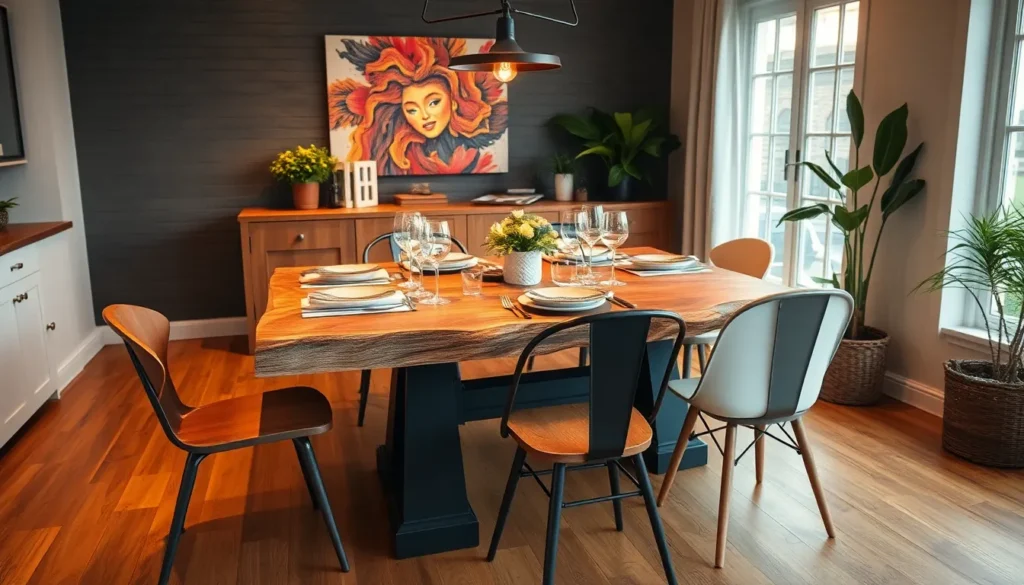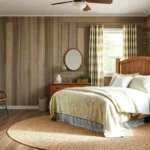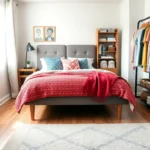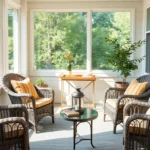We all know that feeling when we walk into a dining room and something just feels off. Maybe it’s the mismatched chairs or the table that’s too small for family gatherings. The dining table isn’t just furniture – it’s where we create memories over shared meals and lively conversations.
Finding the perfect dining table can transform your entire space from ordinary to extraordinary. Whether you’re working with a cozy apartment or a spacious formal dining room we’ve got ideas that’ll make your neighbors wonder where you found such incredible style.
From rustic farmhouse vibes to sleek modern designs we’re about to share dining table ideas that’ll have you excited to host your next dinner party. Get ready to discover answers for every budget space and style preference that’ll turn your dining area into the heart of your home.
Choose the Perfect Size Dining Table for Your Space
Selecting the right size dining table transforms your space from cramped to comfortable. We’ll guide you through the essential measurements and considerations that ensure your table fits perfectly in your dining area.
Measure Your Dining Room Dimensions
Start by measuring your dining room’s length and width to establish your available space. Record these measurements in feet, then subtract 6 feet from each dimension to determine your maximum table size.
Leave at least 3 feet of clearance on all sides of your table for comfortable movement. This spacing allows chairs to be pulled out easily and gives people room to walk around the table without bumping into walls or furniture.
Account for built-in features like bay windows, radiators, or architectural elements that might affect your table placement. These features can reduce your usable space significantly, so measure their dimensions and mark their locations on your room layout.
Consider Traffic Flow and Chair Clearance
Plan for 24 inches of space behind each chair when someone is seated at the table. This measurement ensures people can sit comfortably without their chairs hitting walls or other furniture pieces.
Add an extra 12 inches behind chairs in high-traffic areas where people frequently walk past. Hallways, kitchen entrances, and main walkways require this additional clearance to prevent bottlenecks during meal times.
Test your layout with masking tape on the floor to visualize how your table will fit. Create an outline of your proposed table size and practice walking around it to identify any potential traffic flow issues.
Select Between Round, Square, or Rectangular Shapes
Choose round tables for smaller spaces as they eliminate sharp corners and create better flow in tight quarters. Round tables typically seat 4-6 people comfortably and work well in square dining rooms or breakfast nooks.
Opt for rectangular tables in longer rooms to maximize seating capacity and complement the room’s proportions. These tables work best in spaces that are at least 2 feet longer than they are wide, accommodating 6-10 people depending on size.
Consider square tables for intimate gatherings of 4-8 people in square-shaped rooms. Square tables create equal distance between all diners and work particularly well in open-concept spaces where the dining area connects to other rooms.
Select Materials That Match Your Style and Budget
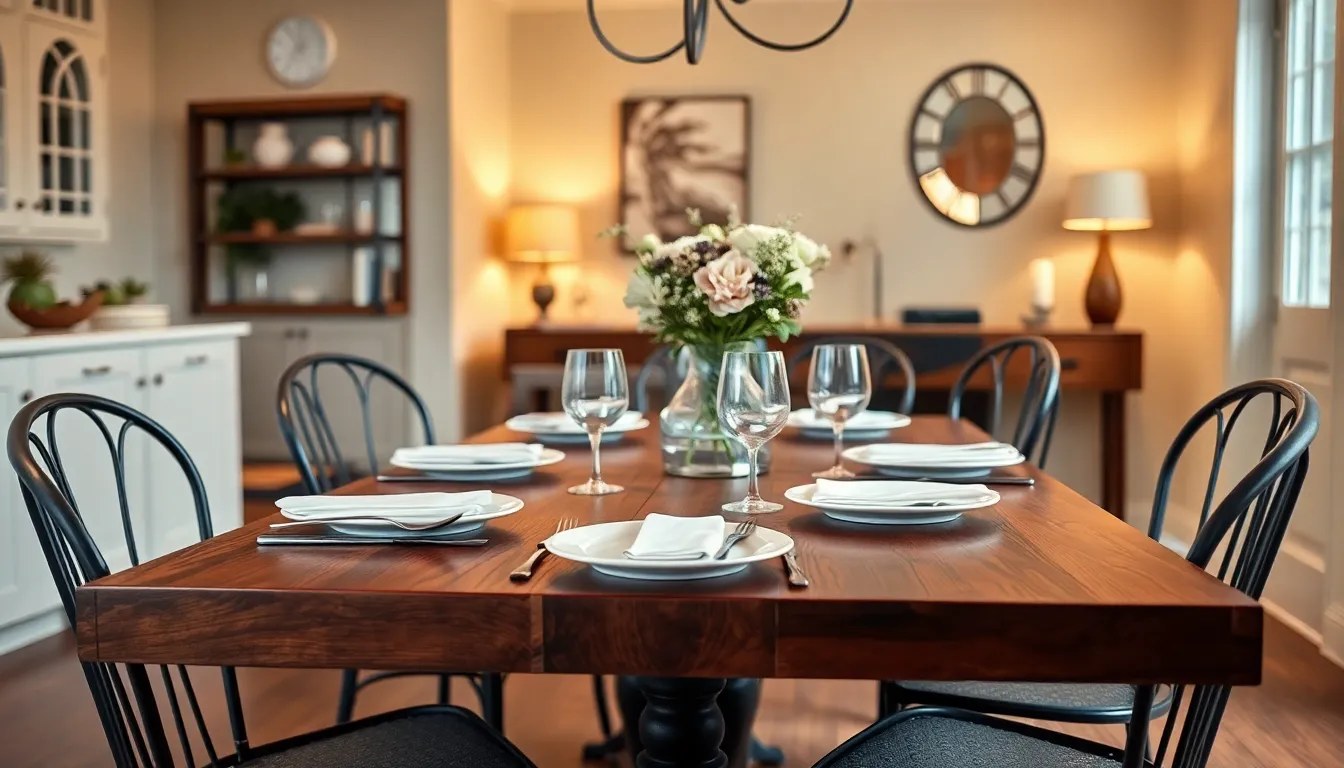
Materials define both the aesthetic appeal and long-term investment value of your dining table. We’ll guide you through the most popular options to help you make an well-informed choice.
Explore Solid Wood Options for Timeless Appeal
Solid wood dining tables offer unmatched durability and natural beauty that improves with age. Oak provides exceptional strength with prominent grain patterns that suit traditional and farmhouse styles perfectly. Maple delivers a lighter tone with subtle grain textures that complement contemporary and Scandinavian designs beautifully.
Cherry wood develops rich, warm tones over time and works exceptionally well in formal dining spaces. Walnut creates stunning contrast with its dark chocolate hues and distinctive grain patterns ideal for modern and mid-century furniture arrangements. Hickory brings rustic charm with its varied grain patterns and natural color variations perfect for country and lodge-style homes.
Handcrafted solid wood tables can be customized to fit your exact space requirements and design preferences. Reclaimed wood options add character and sustainability to your dining area while creating distinctive conversation pieces with unique weathering patterns and historical charm.
Consider Glass Tables for Modern Minimalism
Glass dining tables create an illusion of space that makes smaller dining areas appear larger and more open. Tempered glass surfaces provide excellent durability while maintaining the sleek, transparent aesthetic that defines modern minimalist design principles.
Easy maintenance makes glass tables practical for busy households since spills and stains wipe away effortlessly without staining or absorption. Metal bases paired with glass tops add contemporary sophistication and structural stability to your dining arrangement.
Wooden frames combined with glass surfaces offer warmth while preserving the light, airy feeling that glass provides. Beveled edges and frosted glass options add subtle design elements without overwhelming minimalist decor schemes.
Evaluate Metal and Mixed-Material Combinations
Metal frames bring industrial strength and contemporary styling to dining tables while supporting various tabletop materials effectively. Stainless steel bases offer corrosion resistance and easy cleaning that works well in modern kitchen dining areas.
Wrought iron provides decorative possibilities with scrollwork and custom designs that enhance traditional and Mediterranean decor styles. Powder-coated aluminum delivers lightweight durability perfect for outdoor dining spaces and covered patios.
Mixed material combinations create versatile design opportunities that blend different aesthetic elements seamlessly. Wood and metal pairings offer warmth with industrial edge that suits transitional and eclectic interior designs. Glass and metal combinations provide modern sophistication with structural reliability for contemporary living spaces.
Create Visual Interest With Unique Table Bases

The foundation of your dining table creates the first impression and sets the tone for your entire dining experience. Unique table bases transform ordinary meals into extraordinary moments while showcasing your personal style.
Incorporate Pedestal Bases for Classic Elegance
Pedestal bases eliminate traditional table legs to create a sleek, modern aesthetic that never goes out of style. We’ve seen how these bases open up visual space around your dining area while providing maximum legroom for comfortable seating arrangements.
Contemporary luxury stone bases from companies like Stone Yard Inc. add sophisticated elegance to any dining room design. Stone pedestals create stunning focal points that work beautifully with both marble and wood table tops.
Custom metal pedestal options offer modern interpretations of classic designs. Twist, Pluto, Poseidon, and Apollo table bases from Custom Metal Home range from $730 to $1,995 and provide striking contemporary appeal. These handcrafted metal pedestals combine durability with artistic flair.
Add Industrial Charm With Metal Trestle Legs
Metal trestle legs bring urban sophistication and rustic charm to your dining space. We recommend this style for homeowners who want to create an edgy, warehouse inspired atmosphere in their dining rooms.
Industrial trestle designs work exceptionally well in loft apartments and contemporary homes with exposed brick or concrete elements. The sturdy metal framework provides excellent stability while making a bold design statement.
Combining metal trestle legs with reclaimed wood tops creates the perfect balance between raw industrial appeal and warm natural textures. This pairing offers both durability and character that improves with age.
Choose Live Edge Wood for Natural Beauty
Live edge wood brings the organic beauty of nature directly into your dining room. We love how the unfinished, natural edges create stunning visual effects that connect your indoor space with the outdoors.
Each live edge piece tells a unique story through its natural grain patterns, knots, and irregular edges. These distinctive characteristics ensure that no two tables look exactly the same, making your dining table a true conversation piece.
Pairing live edge tops with modern metal bases creates an striking contrast between organic and industrial elements. This combination works beautifully in both rustic farmhouse settings and contemporary urban spaces.
Amish handcrafted tables from Countryside Amish Furniture showcase the finest live edge woodworking with solid wood construction and custom finishes. Their skilled artisans preserve the natural beauty while ensuring structural integrity for generations of family gatherings.
Design Around Different Interior Styles

Creating the perfect dining space means choosing a table that harmonizes with your home’s aesthetic vision. We’ll explore how different interior styles can guide your dining table selection to create a cohesive and stunning room.
Embrace Farmhouse Charm With Rustic Wood Tables
Rustic wood tables bring warmth and character to any dining space through natural materials and weathered finishes. Oak and pine serve as popular choices for farmhouse-style dining tables, offering durability alongside authentic charm. Distressed finishes create an aged appearance that tells a story, while live edges preserve the wood’s natural curves and imperfections.
Materials like reclaimed barn wood add historical significance to your dining area. These tables often feature visible grain patterns and natural knots that highlight the wood’s organic beauty. Metal hardware and iron accents complement the rustic aesthetic while providing structural support.
Decor pairing transforms your farmhouse table into the room’s focal point. Vintage accessories such as mason jar centerpieces, weathered lanterns, and antique serving pieces enhance the rustic appeal. Metal accents through wrought iron chairs or galvanized planters create visual contrast against warm wood tones. Greenery from potted herbs, eucalyptus arrangements, or seasonal florals brings life to the cozy atmosphere.
Achieve Modern Sophistication With Sleek Lines
Modern dining tables prioritize functionality and minimalist design through premium materials and geometric forms. Glass tops create an airy feeling in smaller spaces while reflecting light throughout the room. Steel bases provide structural integrity without visual bulk, and lacquered wood surfaces offer smooth, easy-to-clean finishes.
Design elements focus on clean geometry and uncluttered surfaces. Minimal ornamentation allows the table’s form to speak for itself, while sharp angles and straight edges create architectural interest. Functionality drives every design decision, from hidden storage compartments to extendable mechanisms.
Contemporary decor pairing amplifies the modern aesthetic through strategic color choices and lighting. Minimalist accessories like geometric vases or sculptural bowls maintain the clean look without cluttering surfaces. Smart lighting answers such as pendant lights with dimming capabilities create ambiance while serving practical needs. Bold color accents through vibrant artwork or statement chairs add personality without overwhelming the space.
Blend Traditional Elements for Timeless Appeal
Traditional dining tables showcase craftsmanship through rich materials and ornate details. Solid wood options like mahogany and walnut provide the foundation for classic designs, often featuring hand-carved details and decorative elements. Ornate carvings on table legs and aprons demonstrate artisanal skill while creating visual interest.
Classic design elements create sophisticated focal points in formal dining rooms. Turned legs, curved edges, and decorative inlays reflect time-honored furniture making techniques. Rich wood tones develop deeper character over time, making these tables true heirloom pieces.
Traditional decor pairing enhances the table’s elegant presence through complementary accessories. Classic vases filled with seasonal flowers create centerpiece drama, while ornate mirrors reflect light and expand visual space. Rich textiles such as linen table runners, embroidered placemats, or tapestry chair cushions add luxury and comfort. Vintage pieces like silver serving sets, crystal glassware, and antique candlesticks complete the sophisticated atmosphere alongside classic lighting fixtures such as chandeliers or brass sconces.
Maximize Small Spaces With Smart Table Solutions
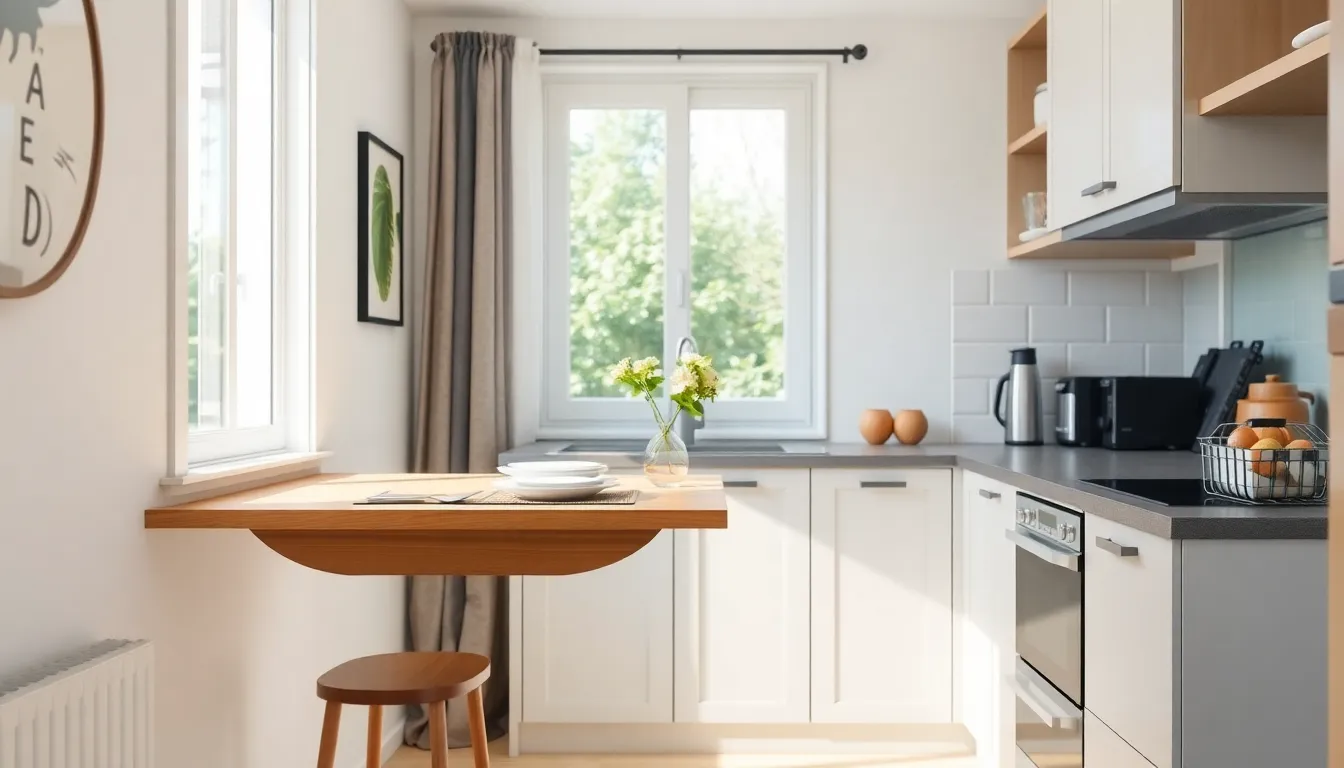
When space is at a premium, we need dining table answers that work harder while taking up less room.
Install Wall-Mounted Drop-Leaf Tables
Wall-mounted drop-leaf tables offer the ultimate space-saving solution for compact dining areas. These clever designs fold flat against the wall when not in use, completely freeing up your floor space for other activities. Installation requires only a sturdy wall mount, making them perfect for apartments, tiny homes, or multipurpose rooms where every square foot counts.
Functionality becomes effortless with these tables since you can quickly fold them down for meals and fold them back up immediately after. We’ve found they work exceptionally well in kitchens, breakfast nooks, or studio apartments where permanent dining furniture would overwhelm the space. Many models accommodate two to four people comfortably when extended, providing adequate dining space without the permanent footprint.
Choose Extendable Tables for Flexible Seating
Extendable tables solve the challenge of hosting guests while maintaining daily space efficiency. Hidden leaves tucked beneath the tabletop can be pulled out instantly to double your seating capacity from four to eight people. This flexibility means you’ll never have to choose between everyday practicality and entertaining capabilities.
Storage becomes seamless since the extension mechanisms are built directly into the table design. We recommend looking for models with smooth-gliding hardware that makes extending and retracting effortless for one person. Quality extendable tables maintain their structural integrity whether compact or fully extended, ensuring stability during both intimate family dinners and larger gatherings.
Consider Nesting Tables for Multi-Functional Use
Nesting tables provide versatile surface answers that stack compactly when not needed. These sets typically include two to three smaller tables that fit perfectly under a larger main table, giving you instant additional surface area for serving, laptop work, or display purposes. Space efficiency reaches its peak with nesting designs since they occupy the footprint of just one table during storage.
Versatility shines through their ability to separate for multiple simultaneous uses throughout your home. We’ve seen them work beautifully as dining extensions, side tables, or even temporary workstations that can be rearranged based on your current needs. The smaller tables often measure 12 to 18 inches in width, making them perfect for tight spaces while still providing functional surface area.
Incorporate Storage Into Your Dining Table Design
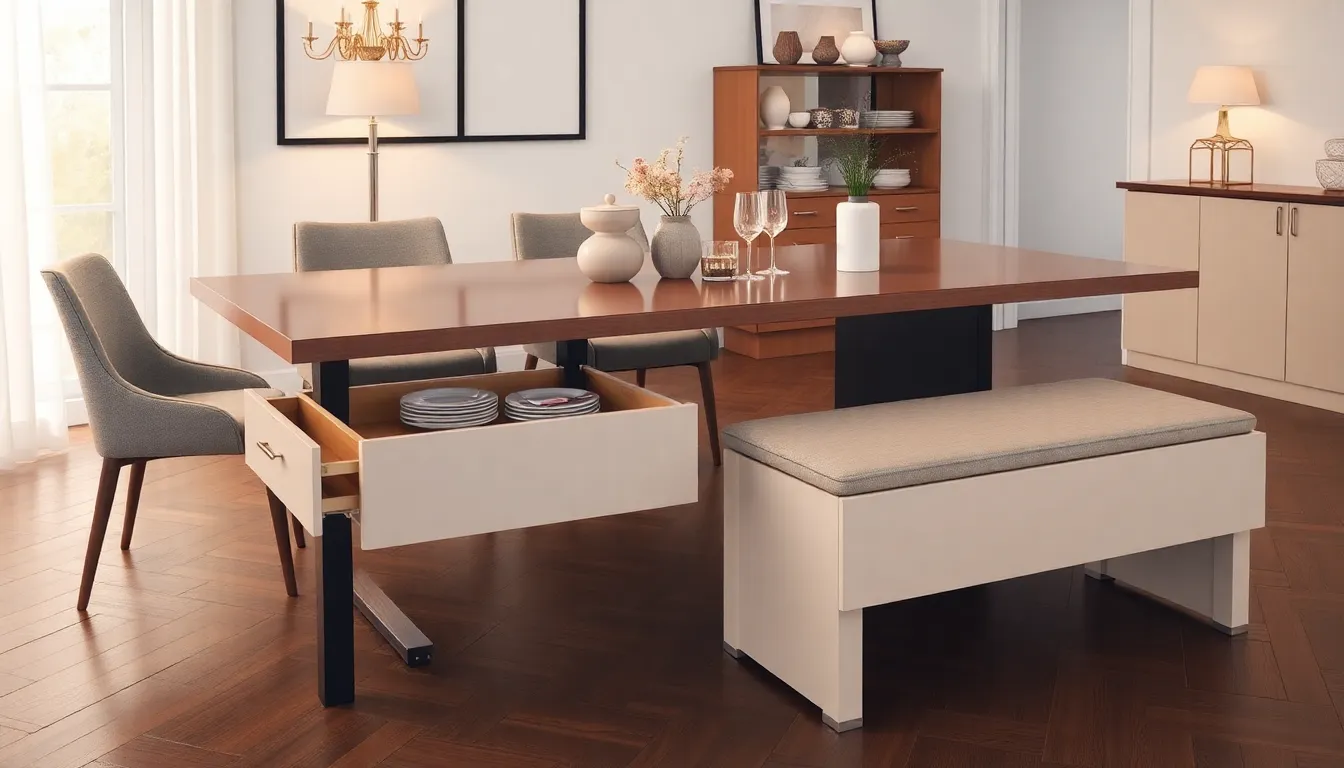
Maximizing functionality while saving space becomes effortless when we integrate storage directly into our dining table design. Modern dining answers combine style with practicality to reduce clutter and keep essentials within easy reach.
Select Tables With Built-In Drawers
Built-in drawers represent one of the most popular storage answers for contemporary dining tables. These convenient compartments provide hidden storage for cutlery, napkins, placemats, and small serving items while keeping everything organized and accessible during meals. Drawers work particularly well in homes with limited storage furniture, as they eliminate the need for additional cabinets or sideboards.
We recommend choosing tables with multiple drawer configurations to accommodate different storage needs. Some designs feature shallow drawers perfect for flatware organization, while deeper options can house serving pieces or table linens. The hidden nature of drawer storage maintains a clean, uncluttered tabletop appearance that enhances any dining room aesthetic.
Add Shelving Underneath for Extra Organization
Under-table shelving utilizes otherwise unused space beneath the tabletop for storing larger dining essentials. Open shelf racks provide accessible storage for tableware, cookbooks, serving platters, and table linens without requiring additional floor space. This solution proves especially efficient in smaller dining areas where every square foot matters.
Modern tables often include pull-out trays or modular shelf systems that can be customized based on storage requirements. These shelving options allow us to keep frequently used items within arm’s reach while maintaining an organized dining environment. The visibility of open shelving also makes it easy to locate exact items quickly during meal preparation or entertaining.
Choose Benches With Hidden Storage Compartments
Storage benches offer a dual-purpose solution that maximizes seating while providing concealed storage space. Lift-up seats reveal spacious compartments perfect for storing bulky items like extra chairs, tablecloths, seasonal decorations, or rarely used serving pieces. This approach becomes especially beneficial in homes where optimizing floor space is essential for daily functionality.
We find that storage benches work well in various dining configurations, from formal dining rooms to casual breakfast nooks. The hidden compartments keep items dust-free and organized while maintaining a sleek exterior appearance. Many contemporary designs feature soft-close hinges and safety mechanisms that prevent accidental slamming, making them safe for households with children.
Style Your Table With Complementary Decor Elements
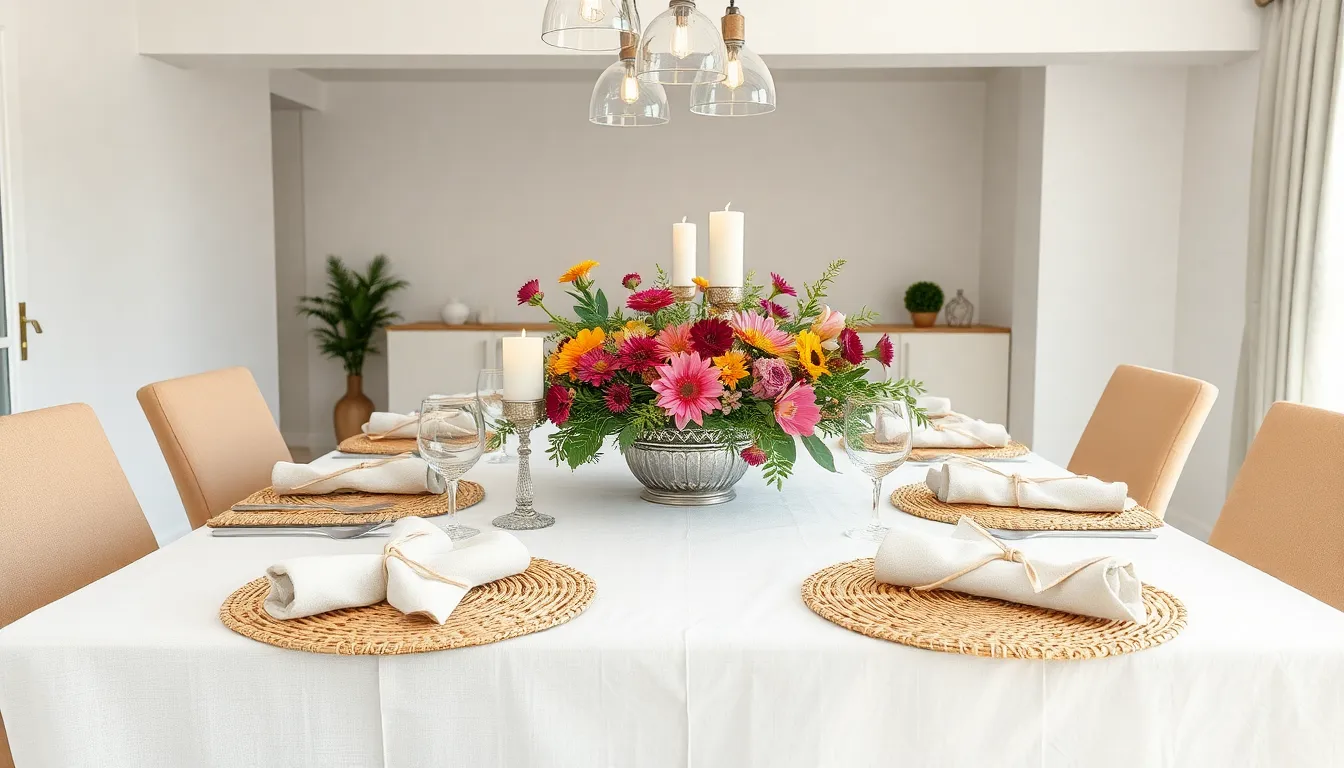
Creating a cohesive dining experience starts with thoughtfully selecting decor elements that work harmoniously together. We’ll explore how strategic layering, lighting, and coordinated furnishings can transform your dining table into a stunning focal point.
Layer Table Runners and Placemats for Texture
Layering table runners and placemats creates visual interest and depth on your dining surface. Start with a neutral tablecloth or runner as your foundation, then add placemats in contrasting materials like linen, rattan, or woven textures. This technique provides texture variation while defining individual place settings for each guest.
Different materials bring unique character to your table setting. Woven rattan placemats offer natural warmth, while linen options provide sophisticated elegance. Contrasting textures between your base layer and placemats establish visual hierarchy and make the dining experience more inviting.
Add Statement Centerpieces and Lighting
Statement centerpieces serve as the focal point of your dining table arrangement. Fresh seasonal flowers, clusters of candles in varying heights, or curated fruit collections create compelling visual anchors. Floral arrangements should reflect the current season and harmonize with your overall room decor for maximum impact.
Lighting plays a crucial role in highlighting your centerpiece and creating ambiance. Pendant lights or chandeliers positioned above the table illuminate decorative elements while providing functional task lighting. Candles add warmth and intimacy to your dining experience, with scented varieties improving the sensory atmosphere through subtle fragrance.
Natural elements like greenery or fresh herb sprigs introduce organic touches that enliven your space. These additions connect your indoor dining area with nature while providing aromatic benefits during meals.
Coordinate Chair Styles and Colors
Chair design and color should complement both your table and overall room aesthetic. Matching chairs create a unified appearance, while thoughtfully mixed styles can add personality without sacrificing cohesion. Upholstered chairs offer comfort and visual softness, whereas wooden or metal options provide structural balance.
Coordinating chair colors with elements like placemats or table runners ensures a balanced design scheme. This approach ties together all your decor elements into one cohesive vision that enhances your dining space’s overall appeal.
Consider Budget-Friendly DIY Dining Table Ideas

Creating a beautiful dining table doesn’t require a massive budget when you embrace DIY answers. We’ll explore affordable approaches that deliver stunning results without compromising on style or quality.
Transform Existing Furniture With Paint and Stain
Paint refreshes old dining tables by giving them completely new personalities and colors that match your current decor. We recommend using high-quality paint primers to ensure long-lasting finishes that resist daily wear and tear.
Stain applications enhance the natural wood grain while updating the color tone to complement modern or traditional dining spaces. Fresh stain coats can transform outdated finishes into rich, sophisticated surfaces that rival expensive new furniture.
Leg replacements offer another transformation opportunity by updating table bases with modern hairpin legs, traditional turned legs, or sleek metal supports. Swapping old legs creates dramatic style changes while maintaining the original tabletop you love.
Hardware updates like new drawer pulls, decorative brackets, or metal accents add finishing touches that complete your table’s makeover. These small details make important visual impacts without requiring major structural changes.
Build Custom Tables Using Reclaimed Materials
Reclaimed wood planks create unique dining surfaces with character marks, weathering, and patina that new lumber can’t replicate. We source materials from old barns, fences, and demolished structures to build one-of-a-kind tables with authentic stories.
Salvaged doors make excellent tabletops when properly reinforced with sturdy leg systems or metal bases. Vintage doors often feature beautiful panel designs, original hardware, and paint layers that add visual interest to dining spaces.
Wooden crates can be assembled into rustic dining tables by connecting multiple crates as both base and storage elements. Stack and secure crates to create functional table bases that provide hidden storage for linens, dishes, or seasonal decor.
Construction materials like old beams, flooring, and siding offer affordable building options for custom dining tables. These materials often cost significantly less than new lumber while providing superior durability and character.
Repurpose Industrial Elements for Unique Designs
Industrial pipe systems using Kee Klamp fittings create modern, sturdy table bases that support heavy tabletops with minimal flexing. We build these tables for under $300 by combining pipe frameworks with reclaimed wood or metal surfaces.
Metal fabrication elements like steel plates, angle iron, and tubing offer endless design possibilities for contemporary dining tables. Distressed metal finishes add industrial chic appeal while providing extremely durable construction that lasts for decades.
Vintage machinery parts such as old gears, wheels, and mechanical components become conversation-starting table bases when properly cleaned and reinforced. These unique elements create focal points that blend industrial history with functional dining furniture.
Factory equipment like old workbenches, conveyor parts, and industrial carts can be converted into distinctive dining tables with minimal modifications. Clean these pieces thoroughly and add appropriate seating height adjustments to create functional dining surfaces with authentic industrial character.
Plan for Entertaining and Special Occasions

Hosting memorable gatherings requires thoughtful table planning that goes beyond everyday dining needs. We’ll explore essential considerations for selecting tables that enhance your entertaining capabilities while maintaining functionality for regular use.
Choose Tables That Accommodate Large Groups
Extendable dining tables offer the flexibility we need for varying guest counts without compromising daily functionality. Tables with removable leaves can transform from intimate family settings to accommodate 10-14 people depending on the design and extension options available.
14-person dining tables require a minimum length of 144 inches to ensure comfortable seating for all guests. Popular configurations include 42×72 inch tables with 6 leaves or 42×96 inch tables with 4 leaves that provide ample space for formal dining experiences.
Custom-made options become essential for groups of 20 or more people. These specialized tables feature various extension styles and include additional center legs for enhanced stability during large gatherings.
Trestle-style bases maximize seating capacity while providing a solid foundation that facilitates easy extension mechanisms. This design eliminates corner legs that might interfere with chair placement around extended tables.
Select Durable Finishes for High-Traffic Use
Solid wood construction delivers the durability and aesthetic appeal necessary for high-traffic entertaining areas. Materials like oak, maple, and walnut naturally resist wear while developing character over time through regular use.
Protective coatings enhance your table’s resistance against spills, scratches, and heat damage that occur during busy entertaining sessions. We recommend professional-grade finishes that maintain their protective qualities even with frequent cleaning and use.
Stain-resistant treatments become particularly valuable for light-colored woods that might show marks more readily. These specialized finishes allow for easy cleanup without compromising the natural beauty of the wood grain.
Reinforced joinery ensures your table remains stable under the weight of large meals and the activity of many guests. Look for tables with mortise and tenon joints or metal brackets that provide long-lasting structural integrity.
Consider Outdoor Dining Table Options
Weather-resistant materials like recycled plastic, teak, or powder-coated aluminum withstand outdoor conditions while maintaining their appearance season after season. These materials require minimal maintenance compared to traditional indoor options.
Extendable outdoor tables allow us to accommodate larger gatherings during favorable weather conditions. Many outdoor models feature the same extension capabilities as indoor tables but with materials designed for weather exposure.
All-season durability becomes crucial when selecting outdoor dining furniture that might face temperature fluctuations, moisture, and UV exposure. We recommend tables with UV-resistant finishes and drainage features that prevent water accumulation.
Portable options provide flexibility for different outdoor entertaining scenarios. Tables with folding mechanisms or lightweight construction allow for easy repositioning based on weather conditions or party size requirements.
Conclusion
We’ve explored countless ways to transform your dining space into something truly special. From choosing the perfect size and material to incorporating smart storage answers and styling touches your dining table can become the heart of your home.
Whether you’re working with a compact apartment or a spacious dining room there’s a solution that fits your needs and budget. The key is understanding your space requirements lifestyle demands and design preferences.
Remember that the best dining table is one that serves your daily needs while creating memorable moments with family and friends. With these ideas and strategies you’re well-equipped to make an well-informed choice that you’ll love for years to come.
Frequently Asked Questions
What size dining table should I choose for my space?
Measure your dining room and ensure at least 3 feet of clearance around the table for comfortable movement. Allow 24 inches of space behind each chair, plus an extra 12 inches in high-traffic areas. Round tables work best in smaller spaces, rectangular tables suit longer rooms, and square tables are perfect for intimate gatherings of 4-6 people.
What are the best materials for dining tables?
Solid wood options like oak, maple, cherry, walnut, and hickory offer durability and timeless appeal. Glass tables provide modern minimalism and easy maintenance, while metal and mixed-material combinations offer strength and design versatility. Consider your lifestyle, maintenance preferences, and design style when choosing materials.
How can I maximize space in a small dining area?
Use wall-mounted drop-leaf tables that fold against the wall when not in use, extendable tables that expand for guests but remain compact daily, or nesting tables that stack together. These solutions provide flexibility while maintaining functionality in tight spaces without compromising on style or dining experience.
What dining table shapes work best for different room layouts?
Round tables promote conversation and work well in square rooms or smaller spaces. Rectangular tables maximize seating capacity and suit longer, narrow rooms. Square tables create intimate settings for 4-6 people and work well in square dining areas. Consider your room dimensions and typical guest count when selecting shape.
How do I incorporate storage into my dining table setup?
Choose tables with built-in drawers for cutlery and dining essentials, add under-table shelving for larger items like tableware and cookbooks, or use storage benches that provide seating while concealing linens and seasonal items. These solutions maximize functionality while maintaining a clean, organized dining space.
What are some budget-friendly ways to update my dining table?
Transform existing furniture with paint and stain, update table legs for a dramatic style change, or add new hardware for a fresh look. Build custom tables using reclaimed wood planks or salvaged doors, or repurpose industrial elements like pipe systems for unique designs that won’t break the budget.
How can I style my dining table for maximum visual impact?
Layer table runners and placemats for texture, use statement centerpieces and strategic lighting to create focal points, and coordinate chair styles and colors for a unified look. Mix heights and textures in your decor elements, and consider seasonal updates to keep your dining space fresh and inviting.
What should I consider when choosing a table for entertaining?
Select extendable tables that accommodate varying guest counts while remaining functional for daily use. Choose durable finishes and solid wood construction for high-traffic entertaining, with protective coatings to resist spills and scratches. Consider the table’s maximum extended size and ensure your space can accommodate it comfortably.

